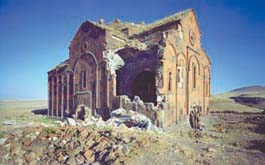Barlow Der Mugrdechian
Advisor

Two years ago, Richard and Ann Elbrecht donated their archive of 157 photographs of Armenian churches on the historic Armenian homeland to the Armenian Studies Program at Fresno State.
Prof. Barlow Der Mugrdechian, Director of the Armenian Studies Program announced that the photographic exhibit, “Churches of Historic Armenia: A Legacy to the World,” is now available on-line on the Armenian Studies Program mirror website at http://armenianstudies2.csufresno.edu/research/churches/index.shtml.
“This collection is an invaluable gift,” said Der Mugrdechian, “It will make the Program the foremost archive of these historic churches anywhere in the world. Placing them on the website makes them accessible to everyone on the Internet.”
Prof. Der Mugrdechian coordinated the process that culminated with putting the photos on-line. Michael Emo of Emo Creative was the project director for designing and implementing the new web site. Campus photographer Randy Vaughn-Dotta assisted in the project with his valuable advice and by organizing the digitalization of the photographs. The Elbrecht’s provided financial support to help complete the project, completing their dream of sharing their photographs with the world. A 1987 vacation to Turkey was the beginning of a twenty-year odyssey that took Richard and Anne Elbrecht on what became a passion – photographing and documenting Armenian churches in the historic homeland of the Armenian people.
As an outcome of their visits with Dr. Dickran Kouymjian, then Berberian Professor of Armenian Studies and Director of the Armenian Studies Program, they decided to donate their archive to the Armenian Studies Program.
The Elbrechts’ first trip to Turkey included not only the obligatory sights, but also a chance visit to the magnificent Church of the Holy Cross on Aght’amar Island in Lake Van. Built in the tenth century by an Armenian King Gagik Ardzruni, the church is an architectural marvel, its exterior walls covered with intricate carvings of scenes from the Bible and Armenian history. Several hundred miles north of Aght’amar, the Elbrechts visited the medieval Armenian city of Ani, with its world famous cathedral and numerous churches, all in a state of ruin due to recurring earthquakes and human neglect. Since then, they have visited and photographed churches in Kars, Mren, Dogubayazit, Van, Moks, Diyarbakir, Urfa, Tarsus, Sis, Kayseri, Kharpert, Malatya, Merzifon, Shabin Karahisar, Gireson, Trabzon, and the Oltu-Penek Valley.
Asked why they have devoted so much of their lives to this project, the Elbrechts explained: “The photographs give meaning to historical accounts, and promote a deeper understanding of the elusive and plaintive history of an extraordinary people and their relationships with the people around them.” The photographs interest people of all ages, including children who ask when and why the churches were built, scholars of art, architecture, and religion, who can see details of church design and decoration not readily available, and Armenians who treasure the images of their historical roots.
The presence of the Armenian Church tells the story of the three thousand years of Armenian presence in the lands where Armenian Christianity took root far more accurately and persuasively than might be told by words. “It is imperative that the government of Turkey with active support from the world allow properly-trained specialists to restore and maintain these monuments – which are indeed Treasures of the World – before they disappear forever.”
Richard Elbrecht passed away in May of 2008. He was a graduate of Yale University and the University of Michigan School of Law. He is survived by his wife Anne Elizabeth Elbrecht, a graduate of Wheaton College, University of California Berkeley School of Library Studies, and McGeorge School of Law. The Armenian Studies Program is grateful to the Elbrechts for their efforts to preserve the legacy of the Armenian people.
 Hye Sharzhoom Armenian Action
Hye Sharzhoom Armenian Action